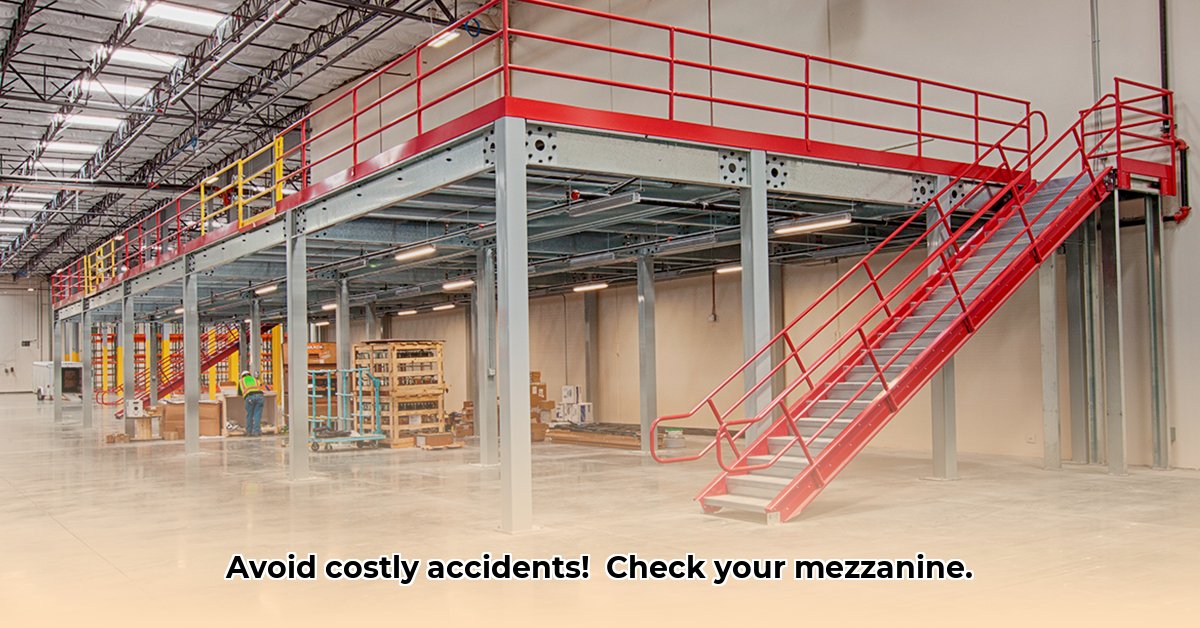Mezzanine Floor Inspection Checklist: Prevent Accidents Now. Worried about your mezzanine floor’s safety? This guide provides a comprehensive approach to mezzanine floor inspections, emphasizing their importance in preventing accidents and ensuring compliance. Learn why regular checks are crucial, how to use a detailed checklist, and how to maintain your mezzanine floor for long-term safety and functionality. We’ll cover common mistakes, explain how to assess your floor’s load capacity, and offer practical tips to protect your business and your people. For further regulatory guidance, see these mezzanine floor safety requirements.
Why Regular Mezzanine Floor Inspections are Essential for Safety and Compliance
Mezzanine floors, those elevated platforms in warehouses, factories, and retail spaces, significantly increase usable space. However, their elevated nature necessitates regular inspections to guarantee safety, maintain operational efficiency, and ensure legal compliance. Investing in regular inspections isn’t just about ticking boxes; it’s about safeguarding your employees, protecting your assets, and preventing costly disruptions.
Understanding the Risks: The Value of Proactive Inspection Programs
A structural failure in a mezzanine floor can have devastating consequences, including severe injuries, operational downtime, legal liabilities, and reputational damage. Overloaded floors, damaged handrails, and obstructed emergency exits are just some of the hazards that can lead to accidents. Proactive inspection programs are your first line of defense, identifying and mitigating potential risks before they escalate.
Comprehensive Mezzanine Floor Inspection Checklist: A Step-by-Step Safety Guide
This detailed checklist provides a structured approach to conducting thorough mezzanine floor inspections, ensuring that safety and functionality are maintained. The frequency and depth of inspections should be tailored to the specific characteristics of your mezzanine floor, considering factors like age, usage, and environmental conditions.
Step 1: The Quick Visual Check (Daily)
This daily walkthrough serves as a basic safety sweep, allowing for general operational awareness. It involves a quick visual assessment to identify any immediate hazards or obvious issues.
- Obvious Damage: Look for any visible cracks in the floor, loose bolts, signs of sagging, or other structural damage.
- Handrails and Guardrails: Ensure handrails and guardrails are sturdy, securely attached, and free from damage. Check for any missing sections or gaps that could pose a fall risk.
- Floor Surface: Inspect the floor surface for noticeable wear patterns, spills, punctures, or other conditions that could compromise stability or create slip hazards. Confirm anti-slip surfaces are intact.
- Obstructions: Ensure walkways and access points are free from obstructions.
Step 2: The Detailed Inspection (Weekly/Monthly)
This more in-depth inspection focuses on structural components and load-bearing elements, requiring a closer examination of key areas. The frequency depends on the mezzanine’s usage and risk factors.
- Structural Integrity: Thoroughly examine support beams, columns, and connections for signs of stress, rust, corrosion, bending, or unusual wear. Pay particular attention to welds and bolted connections.
- Bracing and Anchorage: Verify that all bracing and anchorage components are securely fastened and in good condition.
- Loading: Assess the weight distribution on the mezzanine floor. Ensure that the load is evenly distributed and within the floor’s maximum weight limit. Verify that weight limits are clearly marked and readily visible to all workers.
- Lighting: Confirm adequate lighting is available and functioning correctly throughout the mezzanine area.
Step 3: Safety Features Check (Weekly/Monthly)
This step focuses on verifying the functionality of safety features and emergency protocols.
- Emergency Exits: Ensure emergency exits are clear, accessible, and well-lit. Confirm that exit routes are free from obstructions.
- Emergency Lighting and Alarms: Test emergency lighting and alarm systems to ensure they are fully operational.
- Sprinkler Systems: Conduct a visual check of sprinkler systems to ensure they are in place and appear ready to function. Consider scheduling professional inspections of the system.
- Fire Extinguishers: Inspect fire extinguishers to ensure they are charged, accessible, and in good working order. Employees should be trained on their proper use.
Step 4: The Annual Professional Inspection
Engage a qualified structural engineer or certified inspector to conduct a comprehensive annual inspection. This professional assessment can identify hidden issues that may be missed during routine visual checks, especially in older mezzanine floors or those subjected to heavy use.
Step 5: Documentation – Your Safety Record
Maintaining detailed records of all inspections is crucial for tracking trends, demonstrating compliance, and facilitating effective maintenance.
- Detailed Notes: Record all findings, including the location, severity, and any recommended actions for each issue.
- Visual Evidence: Use photographs or videos to document any problems identified. This visual record can be invaluable for communicating issues and tracking progress on repairs.
- Maintenance Log: Maintain a log of all maintenance performed, including dates, descriptions of work, and the individuals or companies responsible.
Step 6: Scheduling Your Inspections
Establish a clear inspection schedule, assigning responsibility for each type of inspection.
- Daily Visual: Conducted by employees working on or near the mezzanine floor.
- Weekly/Monthly Detailed: Conducted by designated safety personnel or supervisors.
- Annual Professional: Conducted by a qualified structural engineer or certified inspector.
Customize the inspection schedule based on your mezzanine floor’s specific characteristics, usage patterns, and risk factors.
How to Address Mezzanine Issues: From Minor Fixes to Major Overhauls
Address identified issues promptly, ranging from simple repairs to major structural work.
Minor repairs, such as tightening loose bolts, patching small cracks, or replacing damaged handrails, can often be handled in-house by trained personnel. However, more significant structural issues, such as large cracks, corrosion, or signs of significant deterioration, require the expertise of a qualified engineer or contractor. Do not delay addressing these issues, as they can compromise the safety and stability of the mezzanine floor.
Preventive Maintenance: Taking a Proactive Approach for Mezzanine Floors
Implement a proactive preventive maintenance program to extend the life of your mezzanine floor and minimize the risk of accidents.
- Regular Cleaning: Keep the mezzanine floor clean and free from debris, spills, and other hazards.
- Scheduled Repairs: Address minor issues promptly to prevent them from escalating into more significant problems.
- Ongoing Monitoring: Continue to conduct regular inspections to detect potential problems early.
- Rust Prevention: Apply anti-corrosion coatings on steel components as needed, particularly in humid or coastal environments.
Think of preventive maintenance as an investment in the long-term safety and functionality of your mezzanine floor. Just as routine maintenance keeps a car running smoothly, regular attention to your mezzanine ensures a longer, safer lifespan, saving on costs, and promoting safety.
The Bottom Line: Safety Must Always Come First
Regular mezzanine floor inspections are not merely a formality; they are an essential component of workplace safety and regulatory compliance. By following this checklist, implementing a proactive maintenance program, and prioritizing safety, you can significantly reduce the risk of accidents, protect your workforce, and ensure the long-term functionality and value of your mezzanine floor. Remember, safety is an investment, not an expense, with a significant return in the form of a safe, efficient, and productive workplace.
Comprehensive Mezzanine Floor Inspection Checklist Creation Guide
Key Takeaways:
- Regular inspections are critical for maintaining safety and preventing costly repairs.
- A well-structured checklist ensures thoroughness and consistency.
- Varying inspection frequencies are necessary for different checks (daily, weekly, annual).
- Comprehensive documentation is vital for tracking issues and demonstrating compliance.
- Proactive maintenance extends the mezzanine’s lifespan and minimizes risks.
Importance of Inspections for Workplace Safety and Efficiency
Mezzanine floors are vital for optimizing space and enhancing operations within commercial and industrial buildings. Regular inspections are crucial to ensure the safety of employees and the structural integrity of these platforms. Neglecting inspections can lead to workplace accidents, property damage, and legal liabilities. Therefore, developing a comprehensive mezzanine floor inspection checklist is essential for minimizing risks and maintaining a safe and efficient work environment.
Creating Your Comprehensive Mezzanine Floor Inspection Checklist
Developing a robust checklist requires a systematic approach.
- Identify Key Areas: Begin by identifying the specific areas that require inspection. These typically include structural components (beams, columns, decking), safety features (handrails, stairways, emergency exits), and operational aspects (load capacity, storage practices).
- List Inspection Items: For each area, create a list of specific items to inspect. Examples might include “Check for cracks or damage in support beams,” “Verify handrail height and stability,” or “Inspect for signs of overloading.”
- Define Acceptable Conditions: Clearly define what constitutes an acceptable condition for each listed item. For example, are minor cracks acceptable, or what is the minimum acceptable handrail height? Clearly defined parameters are crucial for objective assessments.
- Develop the Checklist Format: Organize the inspection items into a logical sequence within a user-friendly format. Consider using a table or a numbered list to ensure ease of use and efficient completion. A digital format can streamline the inspection process and facilitate better record-keeping.
- Include Visual Aids (Optional): Incorporate photos or diagrams that illustrate acceptable versus unacceptable conditions for selected items. Visual aids can enhance clarity and reduce the potential for misinterpretations, particularly when assessing structural issues.
- Develop a Reporting System: Include sections for recording dates, inspector names, and detailed descriptions of any identified problems. A thorough reporting system is crucial for tracking issues, monitoring trends, and facilitating timely repairs. Design
- Gray Kitchen Backsplash Ideas: Find Your Perfect Gray Tile - December 11, 2025
- Glass Wall Tiles For Bathroom: A Stylish, Durable Choice - December 10, 2025
- Glass Mosaic Kitchen Backsplash: Add Shimmer and Style - December 9, 2025









